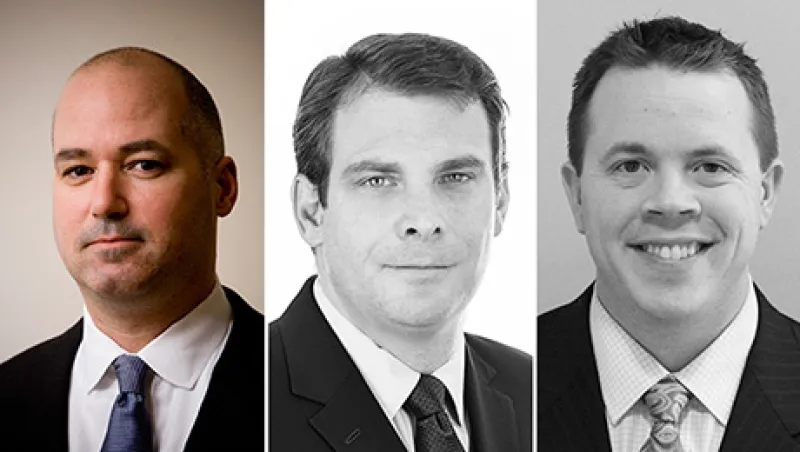The U.S. exchange-traded fund industry is eagerly waiting to see if the Securities and Exchange Commission will approve “nontransparent” actively managed ETFs, and news on that front might be imminent. Meanwhile, a group of sponsors has been launching and building classic, fully transparent, actively managed funds that report their holdings daily.
If the SEC green-lights proposed ETF structures that would allow portfolio managers to conceal daily trading activities from their rivals, it should open the door to more actively managed equity ETFs. But for now the segment is still dominated by bond and currency ETFs and by the four firms with the most products and assets: Pacific Investment Management Co., First Trust Advisors, WisdomTree Investments and AdvisorShares Investments.
The number of U.S. actively managed ETFs with $100 million or more in assets has grown from 18 on September 30, 2013, to 33 as of this October 9, according to research firm Morningstar. The latter tally includes seven of the ten funds launched in August by WBI Investments of Red Bank, New Jersey.
Combined assets for the category rose 15.7 percent during the same period, from $14.6 billion to $16.9 billion, Chicago-based Morningstar reports. This total climbed even though 2013’s No. 1 fund, PIMCO’s Total Return ETF (BOND), fell from $3.9 billion to $2.7 billion.
In late September, PIMCO co-founder and bond guru Bill Gross made headlines by departing for asset manager Janus Capital Group. Denver-based Janus has since announced that it is buying VS Holdings, the parent of ETF provider VelocityShares, which would give Gross a platform to launch his own exchange-traded fund.
But when it comes to the loss of assets at Newport, Beach, California–based PIMCO, it “looks like the outflows have been contained to BOND,” Scott Burley, an analyst at news and analysis site ETF.com in San Francisco, says by e-mail. After Gross left, PIMCO’s Enhanced Short Maturity ETF (MINT) “actually had net inflows,” Burley notes. Over the past year MINT’s assets have been fairly steady at the $3.8 billion level; the fund is now No. 1 on Morningstar’s list, even though its year-to-date return is just 65 basis points.
What did rise substantially is the overall number of actively managed ETFs, which grew from 64 to 113 as of October 9. That day the space gained a new entrant: Boston-based Fidelity Investments, which launched its first actively managed ETFs, a suite of three bond funds.
An Active Market Actively Managed U.S. Exchange-Traded Funds With More Than $100 Million in Assets
| Name | Ticker Code | Assets ($ Millions)1 | 2014 Year-to-Date Performance1 |
| PIMCO Enhanced Short Maturity ETF | MINT | $3,865.2 | 0.65% |
| PIMCO Total Return ETF | BOND | 2,706.2 | 5.66 |
| First Trust North American Energy Infrastructure ETF | EMLP | 865.9 | 14.57 |
| WisdomTree Emerging Markets Local Debt ETF | ELD | 788.9 | 1.44 |
| AdvisorShares Peritus High Yield ETF | HYLD | 700 | 0.15 |
| Guggenheim Enhanced Short Duration ETF | GSY | 681.8 | 0.57 |
| SPDR® Blackstone/GSO Senior Loan ETF | SRLN | 602.5 | 1.05 |
| PowerShares S&P 500 Downside Hedged ETF | PHDG | 431.8 | 2.30 |
| iShares Short Maturity Bond | NEAR | 388.7 | 0.77 |
| RiverFront Strategic Income ETF | RIGS | 384.8 | 2.29 |
| WisdomTree Asia Local Debt ETF | ALD | 315.5 | 2.70 |
| PIMCO Intermediate Municipal Bond ETF | MUNI | 218.1 | 5.03 |
| Cambria Shareholder Yield ETF | SYLD | 206.8 | 1.39 |
| First Trust Senior Loan ETF | FTSL | 200.8 | 1.61 |
| First Trust Tactical High Yield ETF | HYLS | 185.7 | 2.80 |
| First Trust Global Tactical Commodity Strategy ETF | FTGC | 184.5 | -0.94 |
| AdvisorShares Ranger Equity Bear ETF | HDGE | 183.1 | -3.76 |
| WisdomTree Managed Futures Strategy ETF | WDTI | 181.5 | 4.22 |
| AdvisorShares Newfleet Multi-Sector Income ETF | MINC | 173.5 | 2.35 |
| WisdomTree Chinese Yuan Strategy ETF | CYB | 158.1 | -0.06 |
| SPDR® SSgA Multi-Asset Real Return ETF | RLY | 153.7 | -3.44 |
| WBI Tactical Income ETF | WBII | 147.6 | n/a2 |
| WBI Tactical High Income ETF | WBIH | 144.1 | n/a |
| AdvisorShares TrimTabs Float Shrink ETF | TTFS | 143.8 | 4.11 |
| PIMCO Low Duration ETF | LDUR | 140.2 | 1.783 |
| PIMCO Global Advantage Inflation-Linked Bond ETF | ILB | 120.6 | 6.46 |
| WisdomTree Emerging Markets Corp Bd ETF | EMCB | 114.2 | 6.21 |
| WBI Large Cap Tactical Yield ETF | WBIG | 114.1 | n/a |
| WBI Large Cap Tactical Growth ETF | WBIE | 112.7 | n/a |
| SPDR® SSgA Global Allocation ETF | GAL | 110.2 | 1.39 |
| SPDR® SSgA Income Allocation ETF | INKM | 105.4 | 5.07 |
| WBI Large Cap Tactical Select ETF | WBIL | 104.7 | n/a |
| WBI SMID Tactical Yield ETF | WBIC | 101 | n/a |
| 1 As of October 9. 2 WBI funds launched on August 25. 3 From January 22 inception through September 30. | Source: Morningstar. | ||
First Trust’s 12 actively managed ETFs have $1.6 billion in combined assets. One of the firm’s newer offerings, the First Trust Global Tactical Commodity Strategy ETF (FTGC), has already made it to No. 16 on Morningstar’s list.
“Commodities as an asset class have been losing steam, but we’ve been sort of face to the wind, swimming upstream, in terms of asset gathering,” Issakainen says, pointing out that the fund manages $184.5 million despite a large redemption by a single investor in September. FTGC has lost 94 basis points year-to-date, according to Morningstar. First Trust reports that the fund’s market price has fallen 2.30 percent, but it beat the Bloomberg Commodity index, which lost 7.32 percent.
The reason for FTGC’s comparatively better performance in a down market is that most passively managed commodity ETFs follow indexes that are heavily weighted toward energy. By contrast, FTGC has its largest weighting, 12.7 percent, in silver; and at 35 percent, its allocation to energy is about half the norm, Issakainen notes. First Trust’s strategy aims to “target” and “constrain” volatility, he says, adding that in a volatile sector, this approach is a “big part of the difference.”
WisdomTree offers 14 actively managed ETFs with a total of $1.82 billion in assets, and it has a niche: bonds and currencies in emerging markets, with an emphasis on Asia and Latin America. Most emerging-markets indexes are biased toward Eastern Europe, says Rick Harper, New York–based WisdomTree Asset Management’s head of fixed income and currency, but “the Asian economies are just simply in much better shape.” The same holds true to a “lesser extent” for Latin America, he adds.
At No. 4 on the list, WisdomTree’s biggest actively managed ETF, the $788.9 million WisdomTree Emerging Markets Local Debt ETF (ELD), has Malaysia and Mexico as its top two allocations, at 11.17 percent and 10.99 percent, respectively, according to the firm.
Bethesda, Maryland–based AdvisorShares has the largest group of actively managed ETFs: 26 in all, with a total of $1.5 billion in assets. The firm is something of an exception because it hasn’t been afraid to launch equity ETFs with full daily transparency, says founder and CEO Noah Hamman.
He cites the $143.8 million AdvisorShares TrimTabs Float Shrink ETF (TTFS), which is No. 24 on the Morningstar list. Most actively managed ETFs don’t have long track records, but TTFS’s three-year annualized return through October 9 is 23.78 percent, according to Morningstar. The fund, which posted a one-year gain of 17.68 percent, is up 4.11 percent since the start of 2014.
TTFS is based on a strategy developed by Charles Biderman, chairman and portfolio manager at Sausalito, California–based TrimTabs Investment Research. The fund falls into the buyback category, focusing on “companies that are cash-flow-positive and shrinking their float of outstanding shares,” Hamman says. “Earnings don’t matter,” he asserts; for this strategy, what’s important is the demand for a company’s shares. For example, even if Apple’s earnings are below expectations and its stock price drops, the iPhone maker has a regular buyback program, Hamman explains.
On the question of whether the SEC will finally bless one or more of the proposed structures for nontransparent actively managed ETFs, “Our industry sources have told us that it should happen within the next few weeks,” says Robert Goldsborough, an analyst at Morningstar. If so, the first such funds might start trading early next year. Then the whole landscape could change, with lots of new players on the field.
Get more on exchange-traded funds.






